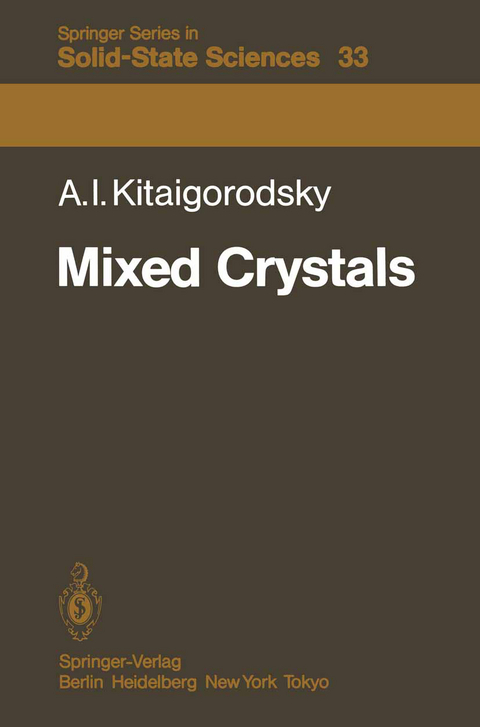
Mixed Crystals
Springer Berlin (Verlag)
978-3-642-81674-1 (ISBN)
1. Introduction.- 1.1 The Early History.- 1.2 Developments of the Twentieth Century.- 1.3 Outline of the Book.- 2. Phase Diagrams.- 2.1 Fundamentals.- 2.2 Conditions of Stability in Mixed Crystals.- 2.3 Types of Phase Diagrams.- 2.4 Determination of Phase Diagrams.- 3. Particle Packing in a Crystal.- 3.1 Elements of the Theory of Space Lattices.- 3.2 Geometric Model.- 3.3 Structure of Single-Phase Mixed Crystals.- 4. Free Energy of a Solid Solution.- 4.1 General Formula for the Free Energy.- 4.2 Solid Solution Characterized by One Interaction Parameter.- 4.3 Limited Solubility.- 4.4 Permutation of Particles in a Rigid Lattice.- 4.5 Lattice Distortions.- 4.6 Thermal Vibrations.- 5. Heterophase Systems.- 5.1 Eutectic Crystallization.- 5.2 Decomposition of Solid Solutions.- 6. X-Ray Scattering.- 6.1 X-Ray Scattering by a Single Crystal.- 6.2 Scattering by One- and Two-Dimensional Systems.- 6.3 Thermal Vibrations.- 6.4 X-Ray Diffraction by Solid Solutions.- 6.5 X-Ray Diffuse Scattering by Solid Solutions.- 6.6 X-Ray Structure Analysis.- 7. Intermetallic Compounds.- 7.1 Classification Schemes for Intermetallic Compounds.- 7.2 Geometrical Analysis.- 7.3 AB Compounds.- 7.4 Compounds AB2.- 7.5 Compounds AB3.- 7.6 Number 13.- 7.7 Close-Packing Principle for Intermetallic Compounds.- 8. Solid Solutions of Metals.- 8.1 Unlimited Solubility.- 8.2 Terminal Solid Solutions.- 8.3 Solid Solutions on the Basis of Intermetallic Compounds.- 8.4 Ordering.- 9. Inorganic Solid Solutions.- 9.1 Isomorphous Substitutions in Alkali Halide Salts.- 9.2 Effect of the Difference in Ionic Size on the Solubility Limits in Systems of Inorganic Compounds.- 9.3 Theory of Ionic Substitutional Solid Solutions.- 9.4 Interstitial Solid Solutions.- 10. Conditions of Formation of Substitutional Organic Solid Solutions.- 10.1 Geometrical Analysis of Substitution.- 10.2 Conditions of Continuous Solubility.- 10.3 Energy Calculations.- 10.4 Unit-Cell Dimensions of Solid Solutions.- 11. Ordering in Organic Solid Solutions.- 11.1 One-Component Crystals with Orientational Disorder.- 11.2 Orientational Disorder in Binary Systems.- 12. Structures of Organic Solid Solutions.- 12.1 Diphenyl-2,2?-Dipyridyl [12.2,3].- 12.2 Para-Dibromobenzene - Para-Chloronitrobenzene [12.4].- 12.3 Acenaphthene - ?-Nitronaphthalene [12.8].- 12.4 Naphthalene - Coumarine [12.11].- 12.5 Dicarboxylic Acids [12.21,22].- 12.6 Naphthalene and Its ? Derivatives [10.14,16,11.25].- 12.7 Solid Solutions of Optically Active Substances or Enantiomers.- 12.8 Durene-Para-Dibromobenzene [12.36].- 12.9 Tolane Diphenylmercury [12.391.- 13. Complexes.- 13.1 Quasi-Valence Bonds Between Molecules of the Components.- 13.2 Complexes of Aromatic and Nitro Compounds.- 13.3 Packing Complexes.- 13.4 Layered Complexes.- 14. Polymers.- 14.1 The Structure of Polymeric Materials.- 14.2 The Structure of Polymer Blends.- 14.3 Block Copolymers.- 14.4 Solid Solutions.- 14.5 Deformation of an Eutectic Mixture.- 14.6 Crystalline Complexes of a Polymer and a Low-Molecular-Weight Compound.- 15. Biopolymers.- 15.1 Proteins.- 15.2 Systems Based on DNA Molecules.- References.
| Erscheint lt. Verlag | 23.3.2012 |
|---|---|
| Reihe/Serie | Springer Series in Solid-State Sciences |
| Zusatzinfo | XIV, 390 p. |
| Verlagsort | Berlin |
| Sprache | englisch |
| Maße | 155 x 235 mm |
| Gewicht | 615 g |
| Themenwelt | Naturwissenschaften ► Physik / Astronomie ► Atom- / Kern- / Molekularphysik |
| Naturwissenschaften ► Physik / Astronomie ► Festkörperphysik | |
| Technik ► Maschinenbau | |
| Schlagworte | Chemistry • Crystal • crystallography • crystal structure • Feste Lösung • Kristallstruktur • Mischkristall • Molecule • Polymer • Structure |
| ISBN-10 | 3-642-81674-6 / 3642816746 |
| ISBN-13 | 978-3-642-81674-1 / 9783642816741 |
| Zustand | Neuware |
| Informationen gemäß Produktsicherheitsverordnung (GPSR) | |
| Haben Sie eine Frage zum Produkt? |
aus dem Bereich


